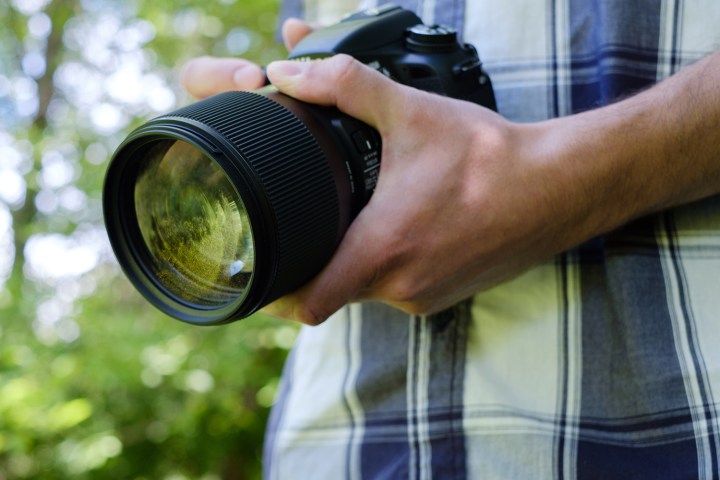

There’s no single definition for what makes a great portrait lens, but the Sigma 135mm f/1.8 DG HSM Art ticks all the boxes and is relatively affordable, to boot. With excellent sharpness and minimal distortion, it is objectively superior to many other lenses, while also rendering backgrounds with beautiful bokeh.
After testing more than two dozen recent lenses, we’ve rounded up some of the top performers for portraits in multiple mounts. From $250 to more than $1,500, here are the best portrait lenses for your camera.
At a glance
| Product | Category | Rating |
| Sigma 135mm f/1.8 DG HSM Art | Best portrait lens overall | 4.5 of 5 |
| Sony E 50mm f/1.8 OSS | Best portrait lens for Sony APS-C mirrorless | Not yet rated |
| Fujifilm XF 56mm f/1.2R | Best portrait lens for Fujifilm X-series | 3 of 5 |
| Panasonic Lumix G 42.5mm f/1.7 | Best portrait lens for Micro Four Thirds | Not yet rated |
| Lensbaby Velvet 85 | Best portrait lens for exploring your creative side | 4 out of 5 |
The best: Sigma 135mm f/1.8 DG HSM Art

Why should you buy this: Fantastic image quality inside a high-end design
Who’s it for: Enthusiasts and pros with full-frame Canon, Nikon, or Sony cameras
How much will it cost: $1,150
Why we picked the Sigma 135mm f/1.8 DG HSM Art:
If you’re a full-frame photographer, the Sigma 135mm F1.8 DG HSM Art is simply one of the best lenses for portrait photography you can buy — at any price. The 135mm focal length is a classic length for portraits, albeit one that has gone somewhat ignored by the likes of Canon and Nikon in recent years, making the Sigma even more unique. It also happens to be one of the sharpest lenses we have ever tested, and the fast f/1.8, nine-blade aperture produces beautiful bokeh. At $1,399, it offers a lot of bang for the buck, with image quality that rivals that of lenses costing many thousands of dollars.
In addition to image quality, autofocus performance is also very good thanks to the latest generation Sigma HSM focusing motor. There is little, if any, difference in AF speed between it and modern first-party lenses, which helps ensure your photos are in focus and tack sharp even when shooting wide open.
Our choice of this lens was made easier by the fact that, being a Sigma, it’s available for multiple mounts. It works equally well on both Canon and Nikon bodies, and is also fully compatible with Sony mirrorless cameras when used with an adapter (Sony users can purchase the lens and adapter together for about $1,650). It’s also available in Sigma’s own SA mount, used by the SD Quattro H and other cameras, although those are not full-frame.
While we rave about this lens on full-frame bodies, we would caution photographers of smaller formats to consider something with a shorter focal length. Even on full-frame, the Sigma 135mm can prove difficult to use when you have limited working space. This problem is exacerbated on smaller sensors, where the focal length is effectively increased. So while this lens will certainly perform well on APS-C cameras from Canon, Nikon, and Sony, the additional crop factor makes it even more unwieldy. Such users may prefer something along the lines of the equally excellent Sigma 85mm F1.4 Art.
Read our full Sigma 135mm f/1.8 DG HSM Art review
The best portrait lens for Sony APS-C mirrorless: Sony E 50mm f/1.8 OSS

Why should you buy this: Fast aperture plus stabilization at a fair price.
Who’s it for: Parents, photo students, and anyone with a Sony APS-C mirrorless camera.
How much will it cost: $250
Why we picked the Sony E 50mm f/1.8 OSS:
When it comes to fast prime lenses, it is rare to find one that also includes image stabilization. But that’s exactly what Sony has done with its E-mount 50mm f/1.8 OSS. The OSS stands for Optical Steady Shot, and it helps reduce motion blur from camera shake at slow shutter speeds. Combined with the bright f/1.8 maximum aperture, this lens is particularly useful indoors or in low light situations.
The lens provides a full-frame equivalent focal length of 75mm, enough to provide a flattering compression effect while maintaining a decent working distance. As it is built specifically for Sony’s APS-C bodies, it is also smaller and lighter weight than the average 50mm. The OSS and shallow depth of field capabilities also make this a great lens for shooting cinematic video.
However, if you shoot an A5000 or A6000 series camera (like an A5000 or A6300) now but are thinking about upgrading to full-frame down the road, you may want to skip the Sony E 50mm as it is not full-frame compatible. Instead, maybe consider going with the newer FE 50mm f/1.8, which is built for full-frame but will also work on your current APS-C Sony. Despite being designed for a larger format, it’s even cheaper at just $200 — but it lacks OSS.
The best portrait lens for Fujifilm X-series: Fujifilm XF 56mm f/1.2R
Why should you buy this: Great image quality and low-light ability
Who’s it for: Enthusiasts and pros shooting Fujifilm X-series cameras
How much will it cost: $999
Why we picked the Fujifilm XF 56mm f/1.2 R:
With an ultra-fast aperture of f/1.2, the XF 56mm F/1.2 R isn’t just one of Fujifilm’s best lenses, it’s one of the best lenses for portrait photography of any system. The 56mm focal length is equivalent to 84mm on full-frame, essentially putting this lens in league with fast 85mm primes that are popular with many full-frame manufacturers. The f/1.2 aperture provides a very shallow depth of field with a beautiful bokeh, and also means the 56mm is going to be better in low-light conditions than any other Fujifilm XF lens (at least with regard to light-gathering capability).
What we really appreciate about this lens is that it is actually usable wide open at f/1.2. Often, lenses are simply too soft at their widest apertures to take advantage of today’s high-resolution sensors. Not so with the XF 56mm.
Arguably, Fujifilm has many other great prime lenses that also work well for portrait photography, but the closest competitor to the 56mm is, well, the other 56mm: the XF 56mm f/1.2 R APD. That version features an apodization filter that removes the bright outlines otherwise present in out-of-focus blur circles, creating an even smoother bokeh. It’s a small difference — sometimes not even noticeable — but certain photographs will benefit. However, the APD filter also cuts back on about a stop of light and makes the lens incompatible with fast phase-detection autofocus. Furthermore, it tacks on several hundred dollars to the price, putting it at $1,499. We feel the standard version is simply the better buy.
Read our full Fujifilm XF 56mm f/1.2R APD review
The best portrait lens for Micro Four Thirds: Panasonic Lumix G 42.5mm f/1.7

Why should you buy this: Small, lightweight, good image quality, affordable
Who’s it for: Panasonic and Olympus shooters who want a compact but capable portrait lens
How much will it cost: $350
Why we picked the Panasonic Lumix G 42.5mm f/1.7:
The Micro Four Thirds (MFT) format uses the smallest sensors of any of the major mirrorless formats, but it has one big advantage: two first-party manufacturers. Both Panasonic and Olympus produce lenses that are compatible on each brand’s camera bodies, and both offer a wealth of excellent glass. But when it came to selecting the best lenses for portrait photography, we decided on one that really plays to the format’s strengths as a compact system: the Panasonic Lumix G 42.5mm f/1.7.
As MFT fans are aware, the 42.5mm f/1.7 is the younger and smaller sibling of the professional grade 42.5mm f/1.2. Both offer an 85mm equivalent full-frame focal length, but while the f/1.2 version costs a sizable $1,600, the f/1.7 model is just $400. Yes, it’s about one stop slower, which means it can’t achieve quite as shallow a depth of field, nor is it as good low light. However, the benefits come in the form of significant size and weight savings (not to mention cost savings). It’s a quality portrait lens that you can take with you anywhere.
For MFT photographers looking to be a bit more adventurous, the Olympus M.Zuiko Digital ED 75mm f/1.8 is a beautiful lens, but with a 150mm full-frame equivalent field of view, it can be a challenge to work with. At $750, it’s certainly more expensive than the Panasonic Lumix G, but that’s quite affordable for such a quality product.
The best portrait lens for exploring your creative side: Lensbaby Velvet 85

Why should you buy this: Highly unique look, versatile macro mode
Who’s it for: Anyone who misses the feel of a quality manual-focus lens or simply wants something different
How much will it cost: $500
Why we picked the Lensbaby Velvet 85:
The Lensbaby Velvet 85 is a manual-focus, manual-exposure lens that’s available in virtually any mount (except those larger than full-frame). It has a fast f/1.8 maximum aperture, but more important is its characteristic “glow” that wraps around portrait subjects. As the lens is stopped down, the glow recedes, allowing you to balance the effect with your desired sharpness. A 2:1 macro mode allows the Velvet 85 to pull a second-shift as a close-up lens, allowing you to narrow in on details in your subject’s face, hands, or clothing.
The lens is also very well made with an all-metal body that feels great in the hand. The aperture is built with 12 rounded blades for circular blur circles even when the lens is stopped down.
The Velvet 85 is certainly not for everyone, but its versatility and truly unique look make it one of the best lenses for portrait photography if you’re willing to put a little work into setting up your shots. Lensbaby also makes a 56mm version, the Velvet 56, which may be more suitable for non-full-frame cameras or indoor use where space is limited.
Read our full Lensbaby Velvet 85 review
How we test
When it comes to testing lenses, we look for a combination of image quality, performance, and price to determine which models offer value advantages. There are many wonderful lenses not mentioned in this article, but it’s not enough for a lens to simply be sharp. The Zeiss Otus 85mm f/1.4, for example, offers incredible image quality, but without autofocus and at a price of nearly $4,500, it falls short in our other metrics.
Where possible, we also looked for lenses that offered unique advantages, bringing something special to the table that helps them stand out from the crowd.
This is but a short list of a few of our favorite portrait lenses. Did we leave anything out? Let us know your own picks for best portrait lens in the comments below!
What is a portrait lens?
Do you really need a specific lens for portraiture? Can’t you take a portrait with any lens? Well, no and yes, respectively. When we talk about “portrait lenses” here, we are referring to two main aspects: focal length and aperture.
Focal length (the millimeter measurement of a lens) affects distortion, with wide-angle lenses typically having a higher amount of it, making them less attractive for portraits. All of the lenses we mentioned here are telephoto lenses, with an equivalent full-frame focal length greater than 50mm. Telephoto lenses tend to have a flattering “compression” effect that is great for portraiture, but they also allow you to get a close-up of your subject without having to be physically close, which tends to be more comfortable for the subject.
Aperture controls depth of a field, and a lens with a larger aperture can produce a shallower depth of field. That is, the depth of area that is in focus will be less, which helps separate your subject from the background. The lenses with the widest apertures are prime lenses, meaning they offer a single focal length without the ability to zoom.
Does this mean you can’t shoot portraits with a wide-angle, small-aperture, or zoom lens? Certainly not, and there may be situations where you want that stylized look (music concerts, extreme sports, and environmental portraits come to mind). In general, however, sticking to a telephoto lens and setting the aperture as wide as it will go is the best recipe for shooting portraits.




